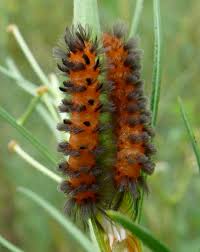By Reba Kocher
Listen to this blog post here: Unexpected_Cycnia.mp3
Because it is Lepidoptera Month, I want to bring awareness to an endangered moth found in Ohio. It is called the Unexpected Cycnia (pronounced “sik-nee-ah") Moth. It is a type of tiger moth, and it looks very similar to the Dogbane Tiger Moth or Delicate Cycnia. As a caterpillar, it has an orange body with grey or black tufts of hair sticking up. In the spring, it emerges as an adult, and it is a stark white color with a light orange line that goes around its head and extends less than halfway back to the wingtip. It lives mostly in the Western region of Ohio, specifically in Oak Openings near Toledo and in the prairie barrens of Adams County.

A photo of two Unexpected Cycnia Moth caterpillars.


Two photos of an adult Unexpected Cycnia Moth. The one on the left shows the moth resting with closed wings. The one on the right shows the moth with open wings, and it gives you a better view of its body.
I am sure you are all tired of me shouting my love of milkweed from the rooftops, but it really is one of the most important genus of plants for pollinators! The Unexpected Cycnia feeds exclusively on milkweed. You can find their eggs and caterpillars on butterfly-weed, which is a milkweed species. One of the reasons why this moth is endangered is because of habitat modification and habitat succession. This means that their habitats, which are a mixture of high quality barrens and dry grassland, are changing. It is mostly due to urbanization and the destruction of grasslands. By removing native plants, like the milkweed, these moths do not have any food sources left, and that is causing them to die at a fast rate! So please be very careful when you see caterpillars and try to keep milkweed around if you can! The Ohio Department of Natural Resources (ODNR) has a conservation plan in place for the Unexpected Cycnia, so hopefully their numbers will begin to increase again. These moths are the most active during June, July, and August. If you get to see one and get a photo, please share it with us! We love seeing all of your photos of Ohio creatures and plants!
References & Further Reading
http://wildlife.ohiodnr.gov/portals/wildlife/pdfs/publications/id%20guides/pub5467.pdf
https://monarchlab.org/resources-links/blog/wanted-unexpected-cycnia-observations
https://www.butterfliesandmoths.org/species/Cycnia-inopinatus
https://kb.osu.edu/bitstream/handle/1811/23380/V090N1_033?sequence=1
